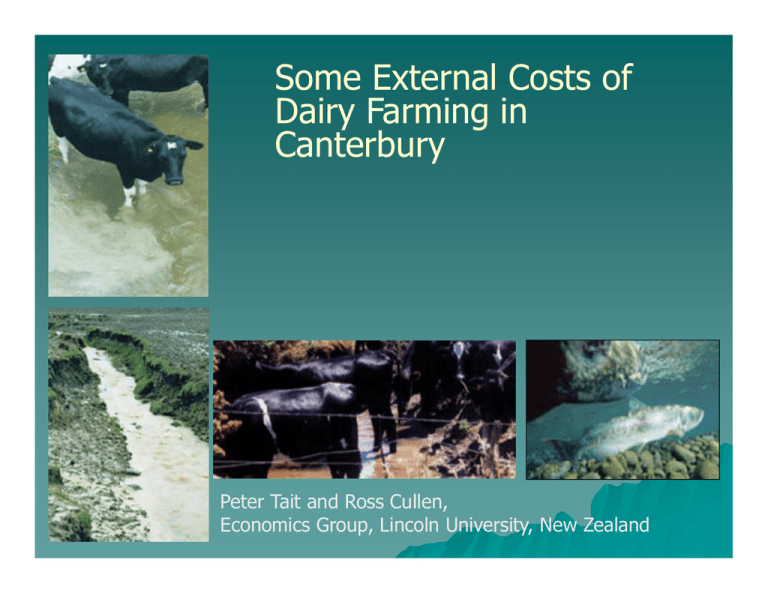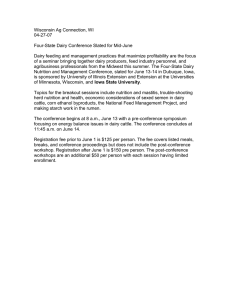Some External Costs of Dairy Farming in Canterbury Peter Tait and Ross Cullen,
advertisement

Some External Costs of Dairy Farming in Canterbury Peter Tait and Ross Cullen, Economics Group, Lincoln University, New Zealand Ecosystem Services (ES) FRST funded research project ‘Ecosystem Services’ ES are crucial for life on earth, but human activities sometimes enhance ES, often degrade ES Objective 1, analyse and value ecosystem services in New Zealand arable, pastoral, horticulture Objective 2, enhance ES and natural capital to improve biological control of pests and diseases Ecosystem Services: The benefits people obtain from ecosystems (Source, Millennium Ecosystem Assessment) Focus: Consequences of Ecosystem Change for Human Well-being. (Source, Millennium Ecosystem Assessment) Canterbury Dairy Farming 390% dairy stock increase 1990-2003, and ≈10% of NZ total About 700 dairy farms 2006 – 729, 2010, 15.3% NZ milk solids 2004/05 Economic farm surplus $374,040 Total farm surplus ≈ $260 million Current concerns emanate predominantly from issues of water quantity and quality Dairy farm conversions continue with land use increasing 132% since 1995 Purpose External costs associated with production are not transmitted through markets for goods produced External costs represent allocation and equity concerns for society and policy makers Studies of external costs provide data that can aid in identifying policy priorities Precedents Pretty et al. (2000) estimated external environmental & health costs of UK agriculture – Identify effects – Assemble available valuation studies – Calculate values using available data Total value of UK external costs, ₤2243 million Tegtmeier & Duffy (2004) estimated external costs of agriculture in USA. Total US external costs US$5.7- 16.9 billion Method Literature review identifying externalities – Canvassed regional policy administrators – Assembled available valuation studies – Calculations employing available data A proxy used is the expenditure which society incurs in dealing with that externality Contributors include – MfE, MAF, ECan, CDHB. Values not included – Antibiotic resistance Damage to Water Resources Damage to Water Resources Surface Water 71% of river sites monitored in Canterbury were not suitable for contact recreation 2004/05 summer These sites provided samples with E. coli concentrations above the action mode guideline of <550 E. coli/100ml The water quality of lowland rivers is the lowest of all the river types and is generally eutrophic Nitrogen and phosphorus concentrations generally exceed MfE guidelines Surface Water cont’d Increased dairy farming has been associated with increasing concentrations of dissolved reactive phosphorous in Southland Nitrate leaching losses are greatest for cow urine A dairy herd crossing a stream temporarily raises E. coli concentrations by 100x the contact recreational guidelines Surface Water cont’d Other expenditure programmes enhancing surface water – Environment Enhancement Fund – Living Streams – Dairying and Clean Streams Accord $100,000 on investigation of land use effects on water quality as direct result of dairy intensification plus 8% of the $190,000 spent on water quality monitoring Damage to Water Resources Groundwater Trend analysis tests conducted on nitrate concentrations from 255 wells in Canterbury identified long-term increasing trends in 43 wells Approximately 5% of 151 wells monitored in 2003/04 had nitrate levels above the MAV A contaminated well can be made deeper to avoid nitrate at considerable cost to the owner Pesticides were detected in 2 of the 8 wells surveyed in Canterbury, with 3 pesticides detected in one and 4 in the other. None of the wells surveyed had pesticides at levels above the maximum acceptable value for drinking water Groundwater cont’d Environment Canterbury spends approximately $500,000 of ratepayers money per annum on groundwater monitoring and management Using the percentage of dairy stock unit numbers, approx 8% as a proxy of expenditure on dairy yields $40,000 per annum Loss of Angler Values Loss of Angler Values Between 1994/95 and 2001/02 there has been a 70% decline in the total number of angler days for Lake Ellesmere and its tributaries Dairy farming requires larger amounts of water than other agricultural activities to maintain the quality and quantity of pasture Benefit Transfer $11.33 - $21.81 per angler visit $8,820 - $16,380 per annum Damage to Air Resources Damage to Air Resources Agricultural sector 49.4% of all emissions Methane from enteric fermentation dominates the sector producing 63.4% of total carbon dioxide equivalent emissions Emissions from dairy – – – – Methane from enteric fermentation Methane from manure management Nitrous oxide from lagoons applied to soil Nitrous oxide from dung/urine deposited on the soil – Nitrous fertiliser emissions Air Resources cont’d Methane emissions from dairy cattle have increased 70.3% since 1990 Increase in the Implied Emission Factor – Increases in animal performance (milk yield) require increased feed intake by the animal to meet energy demands. Increased feed intake produces increased methane emissions per animal. Proposed Carbon tax was $15 - $25 per tonne $24.3m - $40.5m per annum Damage to Biodiversity Loss of Shelterbelts Sediment in Surface Water Damage to Biodiversity Shelterbelts Dairy conversions have had a negative impact on the number of shelterbelts – Shelterbelts removed to allow favourable access to pastures for irrigation Combine data from two surveys – Canterbury Regional Windbreak Scheme (1984) – Environment Canterbury survey (2004) Quantitative measure of the amount of shelterbelt lost per hectare, as a result of a dairy conversion at Te Pirita Shelterbelts Cont’d Subsidy rate combined with shelterbelt per hectare loss rate and land use change data Multiplying the subsidy rate and metres loss provides an estimate of the cost of shelterbelt losses and is equal to $2,947,330 Damage to Biodiversity Sediment in Surface water Fine sediment stops photosynthesis in turbid waters and subsequently kills plants and starves those dependent on them for food Streams with inadequate flow have sediment fall to the bottom filling up the gaps in the gravel bed and killing the eggs of fish Main Causes are animals eroding river banks and Drain cleaning A proportion of expenditure under the Living Streams project is used as a proxy - $17,500 Damage to Human Health Pathogen Related Illnesses Bovine Tb Damage to Human Health Pathogen Related Illnesses Campylobacter rate of incidence 14 cases per 100,000 in 1981 to a high of 396 cases in 2003 Campylobacter frequently present in rural waterways Demonstrated consistent presence of campylobacter in farm dairy effluent Effluent irrigation introduces campylobacter into the environment Pathogen Related Illnesses Cont’d NZ study found campylobacteriosis was responsible for 72.9% of the total costs Cost attributable to dairy $38,523 - $152,344 Bovine Tb Negative consumer perceptions and adverse market reactions 45% of funding comes from rate payers Vector control of possums and ferrets has positive externalities for native forest assets and many species External costs of Bovine Tb control of $1,264,545 Damage estimates Category Water 16 $000’s Surface water Groundwater Angler values Air CO2 equivalent Biodiversity Shelterbelts Sediment Human Health Total 115 40 9- 24,269 - 40,449 2,947 18 Pathogen related illness Bovine TB 39 - 152 1,265 $28,702 - $45,002 Comparisons… External costs of UK agriculture for 1996 estimated to be ₤208 per hectare - NZ$ 516 – Damage to Air resources largest External costs of United States agriculture for 2002 estimated to be $29.44 to $95.68 per hectare – NZ$42.42 to NZ$137.87 – Damage to soil resources largest Costs per hectare for dairy in Canterbury for 2005 estimated at $196.59 to $308.23 – Damage to Air resources largest




